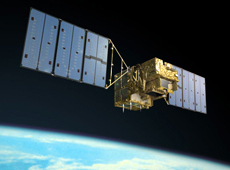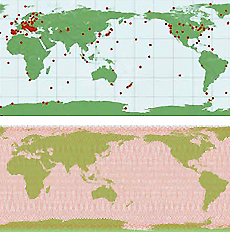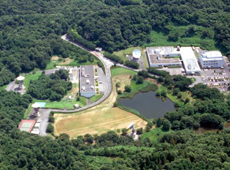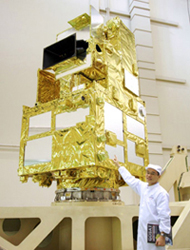
The Greenhouse Gases Observing Satellite (GOSAT) is designed to contribute to the prevention of global warming. Greenhouse gases effect, which cause global warming, consist of roughly 60 percent carbon dioxide and 20 percent methane. GOSAT will precisely and frequently observe the concentration distribution and its changes in these two types of greenhouse gases throughout the world. It will be launched in early 2009 with H-IIA launch vehicle.

Greenhouse Gases Observing Satellite GOSAT
Over the last few years, global warming has become a serious concern around the world. Discussions on how to reduce the rate of global warming are taking place both domestically and internationally, and include such strategies as reducing the level of carbon dioxide emissions by half over the next 50 years.
To accomplish this goal, we must improve the accuracy of observations and long-term climate-change predictions. Up to now, global warming predictions have been performed by research organizations around the world through supercomputer simulations based on ground observation data. In Japan, the National Institute for Environmental Studies, the Meteorological Research Institute, and the University of Tokyo are participating in such global warming modeling.
The Intergovernmental Panel on Climate Change (IPCC) summarizes research results from all over the world and is publicizing a report on climate change predictions for the next 100 years. There are only about 260 ground observation points at present, and they are not evenly distributed, so we can by no means say we are observing the entire globe. Thus, under the present circumstances, global warming predictions vary and may not be accurate.
By comparison, GOSAT will have 56,000 observation points on the Earth, and will be able to acquire data covering the entire globe every three days. We think this will improve the accuracy of global warming predictions.

Current ground observation points (top) and GOSAT's observation points (bottom).
Each country estimates its own emission levels of greenhouse gases, including carbon dioxide. Estimates may be based on consumption of petroleum and coal, and reduced by improvements in the efficiency of power plants, or reduction of petroleum consumption.
However, the accuracy of measurements, calculations and statistics differ from country to country, and the standards and methods are also different. To truly enforce international emission standards, we need international standards for observation methods, data measurements, and calculations.
With GOSAT, we can measure the concentration of carbon dioxide in each area of the world using the same instruments and methods. This data will allow us to estimate the net emission and absorption of greenhouse gases in sub-continental scale. In the future, we might be able to objectively investigate claims of emission reductions and the efficiency of reduction countermeasures. Assessment and promotion of reduction measures, establishment of standards and advancement of technology can effectively follow.
GOSAT can also contribute to greenhouse gas reduction through early detection of methane gas leaks in pipelines. For example, natural gas is produced in the North Sea or Siberia and transported to Europe through thousands of miles of pipelines. A great amount of methane gas reportedly leaks from such pipelines. If we can repair the pipelines right away by detecting any methane gas leaks with GOSAT at an earlier stage, we can reduce methane emissions, leading to a reduction in global greenhouse gases.

JAXA's Earth Observation Center (Hatoyama Station)
Information-sharing systems for GOSAT's results are being developed both domestically and internationally. Data analysis is scheduled to be performed in Japan as a joint project between JAXA, the Ministry of the Environment and the National Institute for Environmental Studies (NIES). NIES has had success with climate change predictions in the past and will do analyses of the concentration distribution of greenhouse gases and the absorption and emission levels of carbon dioxide by region. JAXA and NIES will share the analyzed data with related organizations around the world.
Our negotiations for international cooperation with the European Space Agency (ESA) and the U.S. National Aeronautics and Space Administration (NASA) are becoming more concrete. Cooperation with ESA focuses mainly on data reception and distribution. Data from GOSAT will be received at Hatoyama Station (the Earth Observation Center) in Japan and at the Svalbard Station in Norway. Part of the networking cost of transmitting the data to Japan will be shared by the ESA. In return, JAXA will provide data to the ESA to share with European scientists. The European Centre for Medium-Range Weather Forecasts and various national weather organizations would also like access to GOSAT data. We would like to be able to share this information and are making efforts in this direction.
NASA's Orbital Carbon Observatory is scheduled for launch at about the same time as that of GOSAT. Preparations are underway to provide easy-to-use data from both satellites to the world simultaneously. For example, NASA and JAXA plan to use a common data format and to coordinate a comparison experiment with the satellites, in order to establish common observation standards.

Structural Thermal Model (STM) of GOSAT
GOSAT is scheduled for launch in early 2009. Assembly of the satellite is complete and it is undergoing testing.
The satellite was developed with an emphasis on improved reliability. Even when a satellite is launched successfully, if the observation equipment malfunctions, it becomes difficult to continue the mission. To improve its reliability, GOSAT has dual-wing solar array paddles (most earth observation satellites have just a single-wing paddle), dual observation equipment, and increased durability against scenarios such as small meteorites crashing into the satellite.
Environmental tests simulating the space environment are currently being performed at the Tsukuba Space Center on the completed satellite. A thermal vacuum test will examine whether the satellite's onboard observation equipment will function properly in the vacuum environment and temperature conditions of space. A vibration test will check whether the satellite is durable enough to withstand the vibrations of the launch process.
After these tests have been completed, the satellite will be transported to the Tanegashima Space Center for launch on a H-IIA Launch Vehicle.
JAXA's satellite development and operations contribute to a safe and affluent society. For example, the Advanced Land Observing Satellite "Daichi" (ALOS), which was launched in 2006, is providing disaster information to communities.
Following the launch of GOSAT, JAXA plans to launch more satellites to contribute to global warming countermeasures such as the Global Change Observation Mission, Global Precipitation Measurement, and the Earth Clouds, Aerosols, and Radiation Explorer. To help solve environmental problems, we will comprehensively measure and monitor the Earth, including carbon and water circulation and greenhouse gases.
We have great hopes for the potential of the GOSAT mission to help solve the Earth's environmental crisis. We are making an effort to improve all our lives with the use of Earth observation satellites.
Related Link:
Following the launch of GOSAT, JAXA plans to launch more satellites to contribute to global warming countermeasures such as the Global Change Observation Mission, Global Precipitation Measurement, and the Earth Clouds, Aerosols, and Radiation Explorer. To help solve environmental problems, we will comprehensively measure and monitor the Earth, including carbon and water circulation and greenhouse gases.
We have great hopes for the potential of the GOSAT mission to help solve the Earth's environmental crisis. We are making an effort to improve all our lives with the use of Earth observation satellites.
Related Link:
Takashi Hamazaki
Project Manager, Greenhouse Gases Observing Satellite
JAXA Space Applications Mission Directorate
Mr. Hamazaki received a Master's degree in Aerospace Engineering from the University of Tokyo Department of Engineering in 1979. The same year, he joined the National Space Development Agency (NASDA, now part of JAXA). Mr. Hamazaki worked with the Systems Planning Department and the Satellite Design Technology Laboratory, and has worked for the International Space Station Program as Government of Japan Liaison to NASA. He also served as a deputy project manager for the Advanced Land Observing Satellite. He has been in his current position since 2003. He is an active member of the Space Systems Committee for the International Astronautical Federation.
Project Manager, Greenhouse Gases Observing Satellite
JAXA Space Applications Mission Directorate
Mr. Hamazaki received a Master's degree in Aerospace Engineering from the University of Tokyo Department of Engineering in 1979. The same year, he joined the National Space Development Agency (NASDA, now part of JAXA). Mr. Hamazaki worked with the Systems Planning Department and the Satellite Design Technology Laboratory, and has worked for the International Space Station Program as Government of Japan Liaison to NASA. He also served as a deputy project manager for the Advanced Land Observing Satellite. He has been in his current position since 2003. He is an active member of the Space Systems Committee for the International Astronautical Federation.
To Protect the Environment for a Peaceful Life
Measuring Greenhouse Gases from Space
Understanding the Global Water Cycle
Long-term Environmental Change: Observations of Earth
Three-Dimensional Observation of Clouds and Aerosols
Water, Air, and Waste Recycling
Measuring Greenhouse Gases from Space
Understanding the Global Water Cycle
Long-term Environmental Change: Observations of Earth
Three-Dimensional Observation of Clouds and Aerosols
Water, Air, and Waste Recycling